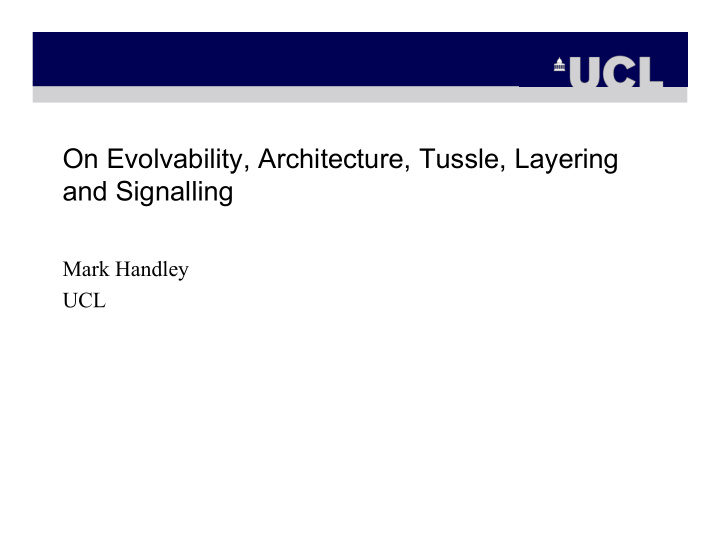



On Evolvability, Architecture, Tussle, Layering and Signalling Mark Handley UCL
Change Huge innovation email WWW phone... in applications SMTP HTTP RTP... TCP UDP… Ossification of the core IP protocols ethernet PPP… CSMA async sonet... Relentless evolution of the underlying copper fiber radio... technology
Tussle and the death of end-to-end. Different parties want varying degrees of control over connections. End systems (obviously) - to enable applications. Firewalls - to enhance security. Deep packet inspection - to differentiate service. Link layers - to enhance transport performance. Transparent caches - to enhance application performance, reduce bandwidth costs. Security services - to be spooky.
Current Layered E2E Architecture App App TCP TCP IP IP IP IP Link Link Link Link Link Link
Current Sort-of-Layered Sort-of-E2E Architecture App App App App TCP TCP TCP TCP IP IP IP IP IP Link Link Link Link Link Link
Evolvability Any new architecture must permit tussles to play out within the architecture. Alternative is: Difficult to evolve because of unintended feature interactions. Eventual ossification and stagnation.
Some New Approaches Role-based Architecture. Connection Signalling.
Role-based Architecture Break packets into separable functionality. Avoids unnecessary coupling as the architecture evolves. Address sub-packets to entities that perform specific roles. Provides a way to talk to an entity (eg Firewall) other than the remote end system. May not know its address (or it may not have an address). Allow entities along the path to add or remove sub-packets as required to perform their job. Provides a place in the architecture for them.
Roles and Role-Specific Headers Role 1 Role 2 Role 3 RSH 1 App Payload RSH 2 RSH 3 packet
Contrived Example RSH( Forward.HbH@*; B, A) RSH( AppMux@B; destPort, SrcPort ) RSH( Firewall@*; ``Disable = Cache'') RSH( Cache@*; ) RSH( DestApp@B; <payload>) Directive indicates data can be cached, but then indicates to the firewall to disable the Caching directive. Allows caching only within the firewall.
Connection Signalling Use a signalling protocol (“CSP”) to initiate all transport connections. Not VCs though, connections can still be datagrams. Not strictly layered under or over transport protocols. More like alongside, akin to how ICMP is to IP. Provides a hook within the architecture for different entities to signal their needs. HTTP, SMTP, RTP, … CSP CSP CSP TCP SCTP UDP ICMP IP
Firewall redirect to offpath proxy CSP aware Firewall Setup(A,p 1 ↔ B,80) Redirect(A,p 1 ↔ P:B,80) A B Setup(A,p 1 ↔ P:B,80) Setup(P,p 1 ↔ B,80) OK OK HTTP HTTP Connection Connection HTTP Proxy
Hidden Mobile Server HA At B Register(S at B) S A OK Setup(A,p 1 ↔ S,p 2 ) Setup(A,p 1 ↔ S:B,p 2 ) Redirect(A,p 1 ↔ S:B,p 2 )+nonce+sig Setup(A,p 1 ↔ S:B,p 2 ) OK Data Transfer (A,p 1 ↔ B,p 2 ) moves Detach+ Attach+Nonce+Sig S OK Data Transfer (A,p 1 ↔ C,p 2 ) At C
Recommend
More recommend